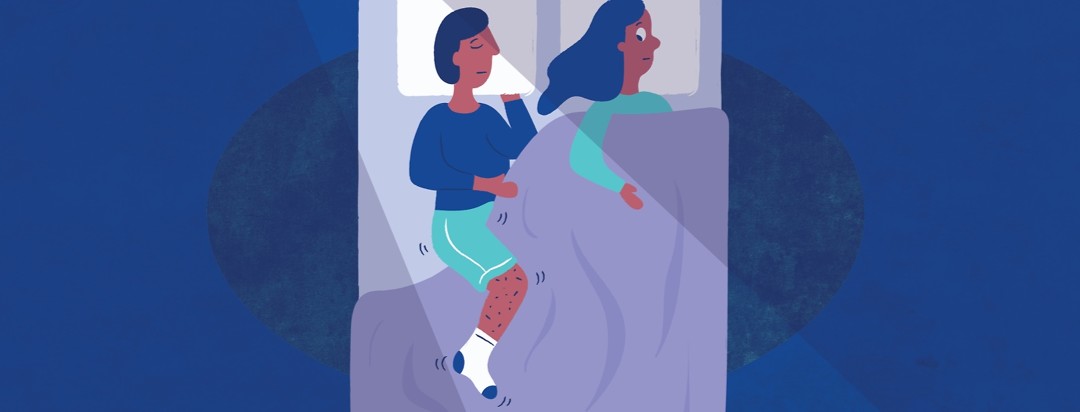Keeping the Beat With Periodic Limb Movement Disorder
I write this, not as a person with PLMD (periodic limb movement disorder), but as someone with a bed partner with this sleep disorder.
There’s nothing unusual about waking up briefly to turn over in the middle of the night. I’ve found, however, that sometimes, as I’m doing this, I notice a little foot action coming from the other side of the bed.
Again, there’s nothing unusual about this. Except when it keeps happening. As a pattern. One I could keep time to. Endlessly (it seems).
Once I became a sleep technologist and sleep health educator, I learned this wasn’t just some quirky affectation of my sleeping partner. This was an actual sleep disorder.
What is periodic limb movement disorder (PLMD)?
By themselves, PLMs (periodic limb movements of sleep) are common. PLMs happen to everybody; having a few at night, especially if they’re slight and unnoticeable, doesn’t mean you have a sleep disorder. PLMs only become a problem (PLMD) when they become frequent and severe enough to disrupt one’s sleep (or the sleep of one’s bed partner).1
PLMs experienced by those with PLMD are involuntary and may be slight. They can also be extremely noticeable, at least to others. They usually involve the pointing and flexing of the big toe. Sometimes the hip, knee, or ankle might also bend during the movement. Typically, they happen during non-REM (rapid eye movement) sleep. Episodes can last as long as an hour.1
A marker of PLMD is its periodic nature. What does this mean? The legs or feet move in rhythmic patterns that recur as frequently as 15 or more times per hour during sleep.2
You can literally “count off” these movements. I’d find myself both in the sleep lab and at home watching or listening for the next “beat” until a string of them concluded. They’re easy to spot during a sleep study, but even while sleeping next to someone with PLMD, you can hear and feel the movement and even count along with it.
PLMD is not the same as RLS
PLMD is a rare cousin to restless legs syndrome (RLS). The two aren’t the same. However, both involve leg movements that can disrupt sleep.
What differentiates PLMD? It generally only happens during sleep, whereas RLS happens at bedtime, delaying sleep. It can reappear in the middle of the night during awakenings.
People with RLS are very conscious of the sensations in their legs. They’ll actively engage in ways to calm them. However, people with PLMD sleep through their leg movements.
What causes PLMD?
Sleep researchers aren’t certain of a root cause for PLMD, but they do know that some medications can worsen it. These include antidepressants, antihistamines, and some antipsychotics.3
Likewise, some medical conditions are linked to PLMD, such as anemia (low blood iron), diabetes, uremia, sleep apnea, and spinal cord injury.3
PLMD doesn’t seem to have a gender link. Nor does age seem to define who’ll get PLMD; young and old get it alike. Its prevalence does seem to increase with age, however.
How is PLMD treated?
First, it requires a diagnosis. It’s common to experience PLMs every once in a while; an overnight sleep study, however, can “draw a map” of leg movement patterns consistent with the sleep disorder to confirm PLMD.4
Talking to bed partners can reveal clues, such as noticeable movements the sleeper isn’t aware of, as well as extremely messy sheets in the morning. People with PLMD also complain of daytime sleepiness.
Blood tests can identify related deficiencies in certain minerals, such as iron, vitamin B12, and others.4
Once diagnosed, PLMD is often treated the same as RLS, with a class of drugs known as dopamine agonists. Sometimes, sleep aids are prescribed.
Discussions about current medical conditions and medications used may take place. Don’t be surprised if a limit on or avoidance of caffeine products is recommended. It seems to exacerbate PLMD.5
If you suspect PLMD in your bed partner
Your bed partner may or may not feel the aftereffects of nightly limb movement patterns. Like snoring, they’re probably unaware they’re doing something that’s completely disrupting your sleep!
However, your sleep’s also important to your overall health and well-being. If you find yourself losing sleep and experiencing daytime sleepiness that isn’t explained otherwise, it’s reasonable to ask your partner to look into their PLMs by having an overnight sleep study.
If they don’t believe you, you might consider setting up a camera to record them. Objective evidence can address what you’re dealing with every night. Most loved ones don’t want to contribute to the sleep problems of their bed partners and should seek help once they understand how disruptive they can be.

Join the conversation